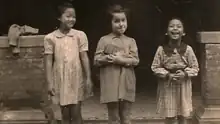Although Japan was a member of the Axis, and therefore an ally of Nazi Germany, it did not actively participate in the Holocaust.[lower-alpha 1] Anti-semitic attitudes were not significant in Japan during World War II and there was little interest in the Jewish question, which was seen as a European issue.[6] Furthermore, Nazi Germany did not pressure Japan on the issue.[6]
Background

In 1936, the German–Japanese Pact, also known as the Anti-Comintern Pact, was concluded between Nazi Germany and Japan,[7]: 111 and it was directed against the Communist International (Comintern). It was signed by German ambassador-at-large Joachim von Ribbentrop and Japanese ambassador to Germany Kintomo Mushanokōji.[8]: 188–189 The Japanese signatories had hoped that the Anti-Comintern Pact would effectively be an alliance against the Soviet Union, which is certainly how the Soviets perceived it.[9]: 226 There was also a secret additional protocol which specified a joint German-Japanese policy specifically aimed against the Soviet Union.[6]: 188–189 [10]: 197 After August 1939, Japan distanced itself from Germany as a result of the Molotov–Ribbentrop Pact.[9]: 24 [11]: 40 The Anti-Comintern Pact was followed by the September 1940 Tripartite Pact, which identified the United States as the primary threat rather than the Soviet Union, however by December 1941 this too was virtually inoperative.[12] The Anti-Comintern Pact was subsequently renewed in November 1941 and saw the entry of several new members into the pact.[13]: 49
During World War II
On December 6, 1938, the Japanese government made a decision of prohibiting the expulsion of the Jews in Japan, Manchukuo, and the rest of Japanese-occupied China. This was described as "amoral", based primarily on the consideration of avoiding antagonizing the United States. Even after Japan and United States became involved in a war against each other, the Japanese government's neutrality towards the Jews continued.[7]: 111–12
Japanese media reported on the rising anti-semitism in Germany, but once Japan joined the Axis, news that presented Germany in negative light were subject to censorship.[6] While some Western media would eventually publish some pieces about the plight of Jews during wartime, this topic was not raised by the Japanese media.[6] Neither did Nazi Germany pressure Japan on this issue, and the Japanese government was not interested in this issue, which most of its members, just like the general public, were simply not aware of.[6]

In 1941, SS-Colonel Josef Meisinger, a Gestapo liaison at the German embassy in Tokyo, tried to influence the Japanese to exterminate approximately 18,000–20,000 Jews who had escaped from Austria and Germany and who were living in the Japanese-occupied Shanghai International Settlement.[14][15] His proposals included the creation of a concentration camp on Chongming Island in the delta of the Yangtze,[16] or starvation on freighters off the coast of China.[17] The Japanese admiral responsible for overseeing Shanghai would not yield to pressure from Meisinger; however, the Japanese built a ghetto in the neighborhood of Hongkew[18] which had already been planned by Tokyo in 1939: a slum with about twice the population density of Manhattan. The ghetto was strictly isolated by Japanese soldiers under the command of the Japanese official Kano Ghoya,[19] and Jews could only leave it with special permission. Some 2,000 of them died in the Shanghai Ghetto during the wartime period; however conditions in the ghetto were described as generally good, as the Japanese authorities did not discriminate against the Jews more so than towards other Europeans in the occupied city.[18][20] A Chinese diplomat in Vienna, Ho Feng-Shan, who disobeyed his superiors and issued thousands of visas to Jewish refugees to go in Shanghai in 1938–1939, would eventually receive the Righteous Among the Nations title.[21]
In 1940–1941, Japanese diplomat Chiune Sugihara, vice-consul of the Empire in the Lithuanian Soviet Republic, granted more than 2,000 transit visas and saved 6,000 Jewish refugees, allowing them to depart Lithuania before it was overrun by the Germans.[22]: 87 [23][24] After the war he was recognized as Righteous Among the Nations, the only Japanese citizen to receive that honor.[24][25]
Many Jewish scientists were involved in the Manhattan Project; Meron Medzini noted that they did not object to dropping the atomic bomb on Japan instead of Germany; and that "we do not know if the [Jewish] scientists were aware that Japan was not involved in the Holocaust", also observing that much of their information about Japan must have come from American wartime propaganda, which sought to "demonize and dehumanize the Japanese people".[26]
After the war

Awareness of the Holocaust in Japan did not immediately increase after the war ended, as neither the Japanese authorities nor the United States occupying forces saw the topic as particularly significant. This changed in the early 1950s, as the topic became popularized by the translation of The Diary of Anne Frank, which was published in Japan in 1952 and sold several million copies.[6] In 1995, the Fukuyama Holocaust Education Center, the only Holocaust-dedicated museum in Asia, was opened.[6]
On the other hand, Holocaust denial views also spread, particularly since the 1980s, popularized among others by works of Masami Uno.[6] In February 1995, a magazine named Marco Polo (マルコポーロ), a 250,000-circulation monthly aimed at Japanese males, ran a Holocaust denial article; it was criticized and the magazine shut down shortly afterward.[6][27]
Japanese officials and scholars often compared American detention camps for the Japanese to the Nazi concentration camps, which has been criticized as part of attempting to minimize Japanese's role as the aggressor in WWII.[6]
See also
Notes
- ↑ This article refers to the Holocaust of the Jewish people. Some scholars also use the term holocaust in the context of the Japanese war crimes against Chinese, Koreans and people of other lands occupied by the Japanese empire.[1][2] The term "Japanese Holocaust" has also been used to describe the atomic bombings of Hiroshima and Nagasaki.[3][4][5]
References
- ↑ Gruhl, Werner (2017-07-12). Imperial Japan's World War Two: 1931–1945. Routledge. ISBN 978-1-351-51324-1. Archived from the original on 2021-09-17. Retrieved 2021-09-17.
- ↑ Sabella, Robert; Li, Feifei; Liu, David (2015-06-03). Nanking 1937: Memory and Healing. Routledge. p. 4. ISBN 978-1-317-46415-0. Archived from the original on 2021-09-17. Retrieved 2021-09-17.
- ↑ Paul, Erik (2012-10-23). Neoliberal Australia and US Imperialism in East Asia. Palgrave Macmillan. p. 117. ISBN 978-1-137-27277-5. Archived from the original on 2021-09-17. Retrieved 2021-09-17.
- ↑ Williams, David; Kersten, Rikki (March 2004). The Left in the Shaping of Japanese Democracy: Essays in Honour of J.A.A. Stockwin. Routledge. p. 139. ISBN 978-1-134-31399-0. Archived from the original on 2021-09-17. Retrieved 2021-09-17.
- ↑ Conrad, Sebastian (2010). The Quest for the Lost Nation: Writing History in Germany and Japan in the American Century. University of California Press. p. 252. ISBN 978-0-520-25944-7. Archived from the original on 2021-09-17. Retrieved 2021-09-17.
- 1 2 3 4 5 6 7 8 9 10 11 Medzini, Meron (2019-01-08). "Chapter 13: The Japanese, the Holocaust of European Jewry, and Israel". Under the Shadow of the Rising Sun. Academic Studies Press. pp. 149–177. doi:10.1515/9781644690246-015. ISBN 978-1-64469-024-6. S2CID 240822988. Archived from the original on 2021-09-16. Retrieved 2021-09-16.
- 1 2 Goodman, David G.; Miyazawa, Masanori (November 7, 2000). Jews in the Japanese Mind: The History and Uses of a Cultural Stereotype. Lexington Books. ISBN 9780739101674 – via Google Books.
- ↑ Hofer, Walther, ed. (1982) [1977]. Der Nationalsozialismus: Dokumente 1933-1945 (in German). Frankfurt/Main: Fischer Taschenbuch Verlag. ISBN 3596260841.
- 1 2 Bosworth, Richard J. B.; Maiolo, Joseph A., eds. (2015). Politics and Ideology. The Cambridge History of the Second World War. Vol. 2. Cambridge: Cambridge University PRess. ISBN 9781107034075.
- ↑ Weinberg, Gerhard L. (1954). "Die geheimen Abkommen zum Antikominternpakt. Dokumentation" (PDF). Vierteljahrshefte für Zeitgeschichte (in German). 1954/2: 193–201 – via Institut für Zeitgeschichte.
- ↑ Boog, Horst; et al. (1998). The Attack on the Soviet Union. Germany and the Second World War. Vol. 4. Oxford: Clarendon Press. ISBN 0198228864.
- ↑ Schroeder, Paul W. (1958). The Axis Alliance and Japanese-American Relations, 1941. Cornell University Press. p. 154. ISBN 0801403715. Retrieved 23 October 2020.
- ↑ Osmanczyk, Edmund J. (1990) [1985]. The Encyclopedia of The United Nations and International Relations (2nd ed.). Bristol: Taylor and Francis. ISBN 0850668336.
- ↑ Japanese, Nazis & Jews: The Jewish Refugee Community in Shanghai, 1938–1945 by David Kranzler. p. 207.
- ↑ Marvin Tokayer and Mary Swartz, The Fugu Plan: The Untold Story of The Japanese And The Jews During World War II, Gefen Publishing House Ltd, 2004. ISBN 9652293296
- ↑ O'Neill, Mark, "A Saved Haven: Plans to rejuvenate Shanghai's rundown former Jewish ghetto will celebrate the district's role as a sanctuary during the Second World War", South China Morning Post, August 1, 2006; Features: Behind the News; p. 11.
- ↑ "Jane Shlensky, "Considering Other Choices: Chiune Sugihara's Rescue of Polish Jews," North Carolina School of Science and Mathematics Durham, NC, 2003, p. 6" (PDF). Archived from the original (PDF) on 2012-03-08. Retrieved 2013-07-08.
- 1 2 Tyler, Patrick E. (29 June 1994). "Patrick E. Tyler, "Jews Revisit Shanghai, Grateful Still that it Sheltered Them." New York Times, June 29, 1994". The New York Times. Archived from the original on July 25, 2021. Retrieved September 16, 2021.
- ↑ Heppner, Ernest G. (2001). "Strange Haven: A Jewish Childhood in Wartime Shanghai (review)". Shofar: An Interdisciplinary Journal of Jewish Studies. 19 (3): 160–161. doi:10.1353/sho.2001.0026. S2CID 170786901.
- ↑ Ernest G. HeppnerShanghai Refuge – A Memoir of the World War II Jewish Ghetto, Bison books, U of Nebraska Press, 1993 Archived 2021-09-16 at the Wayback Machine ISBN 0803223684.
- ↑ "Feng-Shan Ho". yadvashem.org. Archived from the original on 2021-09-16. Retrieved 2021-09-16.
- ↑ Chiune Sugihara and Japan's Foreign Ministry, Between Incompetence and Culpability. University Press of America. November 7, 2001. ISBN 9780761819714 – via Google Books.
- ↑ "Polish Jews in Lithuania: Escape to Japan". encyclopedia.ushmm.org. Archived from the original on 2021-09-16. Retrieved 2021-09-16.
- 1 2 "Chiune (Sempo) Sugihara". encyclopedia.ushmm.org. Archived from the original on 2021-09-16. Retrieved 2021-09-16.
- ↑ Sakamoto, Pamela Rotner (1998). Japanese Diplomats and Jewish Refugees: A World War II Dilemma. Praeger. pp. xi. ISBN 978-0-275-96199-2. Archived from the original on 2021-09-16. Retrieved 2021-09-16.
- ↑ Medzini, Meron (2009-01-01). "Jewish Scientists, Jewish Ethics and the Making of the Atomic Bomb". In Podoler, Guy (ed.). War and Militarism in Modern Japan. Brill. pp. 120–128. doi:10.1163/ej.9781905246854.i-242.62. ISBN 978-90-04-21300-5. Archived from the original on 2021-09-17. Retrieved 2021-09-17.
- ↑ Falk, Avner (2008). Anti-semitism: A History and Psychoanalysis of Contemporary Hatred. ABC-CLIO. p. 106. ISBN 978-0-313-35384-0. Archived from the original on 2021-09-17. Retrieved 2021-09-17.